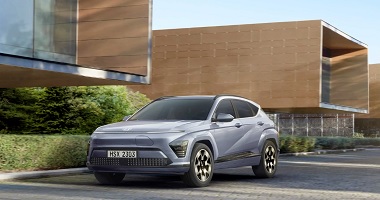
El SUV chico se lanza con variantes a combustión, híbridas y eléctricas. ¿Te gustaría que venga a Argentina? Se develó a nivel mundial la nueva generación del Hyundai Kona, SUV del segmento B vendido en Argentina y cuya flamante entrega se ofrecerá en versiones nafteras, híbridas y eléctricas. A diferencia de lo que suele ocurrir en los lanzamientos, donde las variantes electrificadas se desarrollan a partir de las a combustión, la marca surcoreana comentó que en este caso pasó al revés: del Kona eléctrico se desarrollaron las otras versiones, por lo que el vehículo funciona como si fuera un modelo dedicado a la electricidad. La segunda generación del Kona es uno de los primeros modelos eléctricos que llegan al mercado como parte de la estrategia de electrificación que Hyundai anunció hace un año, y que involucra el lanzamiento de 11 nuevos EVs hasta el 2030. Jaehoon Chang, Presidente y CEO de Hyundai Motor Company, aseguró que el Kona a batería "jugará un papel importante, junto a nuestros modelos Ioniq, para reforzar el liderazgo de la marca en el mercado eléctrico". Veamos qué trae. Nuevo Hyundai Kona: Exterior Hyundai no dio a conocer si la plataforma del Kona es nueva o es una variación de la anterior, pero lo claro es que, al permitir versiones a combustión, no es una base dedicada al mundo de los eléctricos e híbridos, como sí es la que da vida a la familia Ioniq. El nuevo Kona es más grande que su antecesor, aparecido en 2017 y que se vende en Argentina desde 2019: 4.355 mm de largo (+175 mm) 1.825 mm de ancho (+25 mm) 1.575 mm de alto (+20 mm) Distancia entre ejes: 2.660 mm (+60 mm). Capacidad del baúl: 466L (+105L) El diseño de la segunda generación del Kona es más robusto, moderno y tecnológico, pero mantiene el carácter que lo identifica claramente como un Hyundai. Además, cada versión presente un frente propio, con un estilo de trompa de tiburón, una larga tira LED que separa el capot del paragolpes (que en el modelo BEV es de pixeles), y las ópticas principales ubicadas en los laterales del paragolpe, tal como en su antecesor. El coeficiente aerodinámico del nuevo Kona es de apenas 0,27 cx, algo que se puede apreciar en la silueta, que presenta líneas muy marcadas y angulosas, guardabarros salidos del mundo off-road, y una suave caída del techo. En la zaga se repite la tira LED a lo ancho del auto, y se mantienen las luces principales puestas en las esquinas del paragolpe. Por su parte, las versiones N Line contarán con: Carcazas de espejos retrovisores negros Alerón Paragolpes delantero y trasero más agresivos, en forma de ala para enfatizar una postura más baja Salidas de escape doble y y faldón plateado Nuevo Hyundai Kona: Interior Gracias a un desarrollo pensado en el modelo eléctrico, Hyundai logró un habitáculo sumamente espacioso, especialmente en las plazas traseras. El diseño del tablero está orientado a quien lo maneja, y cuenta con dos pantallas "flotantes" integradas en una misma estructura, cada una de 12,3'', para ofrecer en una visión más clara de los marcadores y del sistema multimedia. Con el fin de tener unos asientos delanteros más anchos, el torpedo central fue achicado, Por su parte, el selector de cambio electrónico se colocó detrás del volante, junto con otros controles, lo que permitió generar más espacios de almacenamiento. Nuevo Hyundai Kona: Equipamiento Entre las novedades tecnológicas, el nuevo Kona incorpora: Iluminación ambiental Head-up Display de 12" Modo de conducción i-PEDAL Sistema de sonido e-ASD, que mejora lo escuchado por quien maneja Carga bidireccional para la versión eléctrica Paquete Smart Sense de asistencia al conductor (ADAS), que incluye manejo autónomo de Nivel 2. El flamante Kona incorpora actualizaciones de software Over-the-Air (OTA), un sistema de desbloqueo y arranque con llave digital (a través del reloj o teléfono), y el nuevo Connected Car Navigation Cockpit (ccNC), que proporciona gráficos avanzados, cámara 360º, entre otros. Opcionalmente, puede incorporar el sistema de sonido Premium Bose de ocho parlantes más subwoofer. Nuevo Hyundai Kona: Mecánica Por ahora, Hyundai sólo develó información y fotos del Kona eléctrico, y se reservó para abril la presentación del resto de las variantes. La mencionada versión se vende con dos paquetes de baterías y dos potencias distintas: Más potente Batería de 65,4 kWh Autonomía: 490 kilómetros Motor: 160 kW (217 CV) y 155 Nm Tracción: 4x2 Menos potente Batería de 48,4 kWh Autonomía: se desconoce Motor: 114 kW (155 CV) y 255 Nm Tracción: 4x2 El Kona es compatible con una infraestructura de 400 voltios, por lo que en un cargador rápido es capaz de pasar del 10 al 80% de carga en 41 minutos. El puerto de carga se mantiene instalado en el frente del modelo. Fuente: Autocosmos